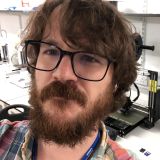
Department of Orthopedics and Trauma-Surgery (Division of Orthopedics)
ORCID: 0000-0002-9928-3631
T +43 1 40400 76530
mario.rothbauer@meduniwien.ac.at
Keywords
3Rs; Arthritis, Rheumatoid; Artificial Organs; Disease modeling; Lab-On-A-Chip Devices; Mechanotransduction, Cellular; Microfluidics; Molecular Biology; Osteoarthritis; Tissue Engineering
Research group(s)
- Orthopedic Microsystems Group
Head: Mario Rothbauer
Research Area: We use microfluidics and lab-on-a-chip principles to create three-dimensional models of the human musculoskeletal system. The groups research focus includes tissue engineering, biomaterial science, bioengineering and the molecular sciences of human musculoskeletal diseases such as rheumatoid arthritis, osteoarthritis as well as tissue fibrosis.
Members:
Research interests
My interdisciplinary background brings together cell biology, chemistry, engineering, material science, microfabrication, biosensing as well as bioengineering to develop miniaturized integrated systems for in vitro cell cultures, 3D cellular assemblies and tissue-like structures with the aim of understanding dynamic cellular responses to extrinsic and intrinsic stimuli and systemic stress factors governing human disease. With my research group I currently focus on musculoskeletal disease models including osteoarthritis, rheumatoid arthritis as well as mechanisms of tissue fibrosis. The overall goal of my research lies in the establishment of next-gen human disease models as complimentary alternative approach to animal models for basic research, translational medicine and pharmaceutical drug screening.
Selected publications
- Rothbauer, M. et al. (2021) ‘Establishment of a human three-dimensional chip-based chondro-synovial coculture joint model for reciprocal cross talk studies in arthritis research’, Lab on a Chip, 21(21), pp. 4128–4143. Available at: http://dx.doi.org/10.1039/d1lc00130b.
- Rothbauer, M. et al. (2020) ‘Monitoring tissue-level remodelling during inflammatory arthritis using a three-dimensional synovium-on-a-chip with non-invasive light scattering biosensing’, Lab on a Chip, 20(8), pp. 1461–1471. Available at: http://dx.doi.org/10.1039/c9lc01097a.
- Shabestani Monfared, G., Ertl, P. and Rothbauer, M. (2020) ‘An on-chip wound healing assay fabricated by xurography for evaluation of dermal fibroblast cell migration and wound closure’, Scientific Reports, 10(1). Available at: http://dx.doi.org/10.1038/s41598-020-73055-7.
- Rothbauer, M. et al. (2019) ‘Monitoring transient cell-to-cell interactions in a multi-layered and multi-functional allergy-on-a-chip system’, Lab on a Chip, 19(11), pp. 1916–1921. Available at: http://dx.doi.org/10.1039/c9lc00108e.
- Rothbauer, M. et al. (2022) ‘A Progress Report and Roadmap for Microphysiological Systems and Organ-On-A-Chip Technologies to Be More Predictive Models in Human (Knee) Osteoarthritis’, Frontiers in Bioengineering and Biotechnology, 10. Available at: http://dx.doi.org/10.3389/fbioe.2022.886360.